How to Choose and Care for Pet Snakes
Like all reptiles, choosing pet snakes depends on your experience,
how the species of snake does in captivity and the amount of care
required. There are many popular varieties of snakes available in pet
stores, at Reptile Expos and from breeders. The large size of many
adult snakes is also an important consideration. Snakes can live from
10 to 20 years or more, so do not get a pet snake unless you are ready
for a long term commitment. See our list of recommended snakes here.
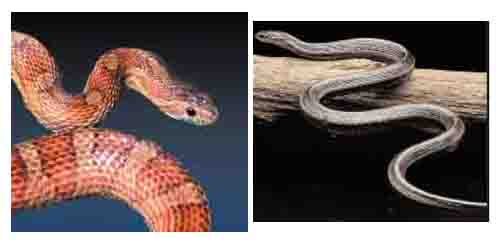
Two of most popular Pet Snakes are
Corn
Snakes and Garter Snakes
Where to Buy Snakes:
In general, all pet snakes kept in captivity should be purchased
from a reputable store or breeder. These snakes are already used to
being in captivity and are more likely to thrive under your care. A
reputable breeder will also start the snake on a diet that will ensure
good health for the life of the animal. Snakes caught in the wild may
not react well to captivity and may have other issues such as
parasites. They may also not acclimate well to being
handled. There are also obvious environmental
concerns. A good online source for snake expos, purchasing and
information on snakes is Kingsnake.
The articles and classified section of Reptile
Magazine is also a good source of snake information.
Before buying ask about guarantees such as health. If you purchase
online, check policy if snake arrives injured or dead. To avoid
problems, try and order snakes during periods of moderate temperatures.
Inspect Snake Health Before Buying:
Be sure to inspect any pet snake before purchasing. Look the snake over for any obvious signs of disease including:- Trauma or Injury
- Dietary problems such as a snake that appears to be too thin
- Skin issues such as areas where the snake has failed to shed
skin, particularly around the eyes which is a sign of a snake health
problem
- Swollen skin areas
- Check belly or underside for any burn marks. Some snake
cages are heated with hot rocks that may cause this injury.
Snake Food
Most snakes rely on meat or insects for protein. Meat is easily
provided in the form of live or frozen
pinkie mice. These can be purchased from a pet store or online.
Snake Cage Considerations
Creating the perfect snake terrarium is part of the fun of raising
snakes. You can either create the perfect environment yourself, or
start with one of the many popular commercial snake kits that includes
everything you need to get started. One approach is to start with a snake
kit, and then slowly customize the environment to meet the needs of
your pet. See the descriptions below for information and
information on each type of pet snake.The type of environment you create for your pet snake is dependent on the following factors:
- Number of Snakes: If you are going to breed and care for multiple
pet snakes, a larger enclosure will be required. Most snakes kept
by beginners require a 20 gallon glass aquarium with a with mesh lid
that tightly fits onto the cage.
- Native Environment: Snakes are found in many types of natural
environments including woodlands, savannas (temperate), semi aquatic,
tropical and semi-aquatic environments. Each of these has unique needs
such as humidity levels, plants, substrates (the material that covers
the bottom of the reptile terrarium and other items referred to as
furniture. Furniture can include places for the snake to hide or
bask in the heat.
- Heat and Light: Snakes are ectotherms, which means that they
regulate their body temperature is regulated by outside temperatures.
Because of this, snake cages need an area which is heated, an area that
is slightly cooler and a night time temperature.
| Natural
Snake Habitat |
Daytime
Temperature |
Heated
Basking area
Temperature |
Required
Humidity Level |
| Semi-aquatic |
60F - 75F (16C - 24C) |
80F - 95F (27C - 35C) |
50% to 80% |
| Tropical |
70F - 85F (21C - 29C) |
85F - 95F (29C - 35C) |
50% to 80% |
| Temperate,
Savanna, Woodland |
65F - 85F (18C - 29C) |
90F - 100F (32C - 38C) |
30% to 50% |
| Desert |
65F - 85F (18C - 29C) |
90F - 100F (32C - 43C) |
10% to 30% |
In a reptile cage, heat is provided by either a pad attached to the outside of the enclosure or a ceramic heat light. The light needs to be far enough from the snake to avoid any risk of burning. The light is usually provided by a broad spectrum UVB light. Sunlight helps the reptile naturally produce vitamin D which is necessary for calcium absorption. If too little light is provided, dietary supplements are required.
- Reptile Terrarium Shape: Cages or aquariums are usually long or
tall. The size is dependent on the adult size and requirements of the
reptile
- Substrate: A substrate is the material placed at the bottom of
the snake cage. If a snake likes to burrow, then the material used
needs to accommodate this behavior. If the snake does burrow, avoid
heavy furniture or decor which could rest on top of the snake. Popular
substrates include shredded newspaper and aspen. Note that some
substrates such as sand could be ingested, causing a digestive system
blockage.
- Water: A shallow dish for drinking and water areas help to reach
the required humidity levels.
- Snake Diet or Food: Reptiles vary based on their choice of
diet. Most reptiles bred in captivity will eat a combination of
foods. There are also commercial diets available for more popular
species.
Popular Pet Snakes
The following list represents some of the best selling and most popular
types of reptiles. They are also the easiest to care for in home
captivity, using either and indoor or outdoor reptile terrarium:- Recommended for Beginners
- For Caretakers with Intermedite Experience
Corn Snakes
Perfect pet snake choice for beginners. Comes in 30
colors and is widely available. Can grow to 30 to 54 inches. Diet
consists of pinkie mice every
two weeks. Corn snakes require a 20 gallon terrarium and
can live for 10 or more years. For more information download this
corn
snake care fact sheet (PDF) from Petco. 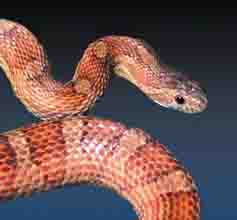
Corn Snakes are Recommended for Beginner Herps
Source: Petco
Rat Snake
The Rat Snake is one of the easiest to handle pet snakes. It is the most commonly found snake in North America. They have a gentle temperament and are easy to care for in captivity. This pet snake can grow to 4 to 8 feed and live for 15 years or longer in captivity. The snake diet is frozen pinkie mice or a commercial snake food. For more information on Rat Snakes, download this Rat Snake care sheet from Petco.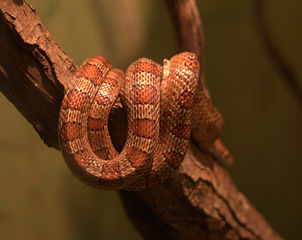
The Rat Snake is one of the best beginner Reptile Pets
Source: Wikimedia, LaggedOnUser
California
Kingsnake and Variable Kingsnake (Thayers Snake)
The California Kingsnake is found in California,
Oregon, Nevada and adjoining states. It can thrive in several
different types of habitats including forests, woodlands and deserts.
The snake can grow to 2 to 4 ft and can live as long as 30+ years in
captivity. They are awake in the daytime (durnal) and if stressed with
give off an odor. California Kingsnakes each mice in captivity. They
are called KingSnakes because they will eat other snakes. Download this
fact sheet for more
information on the California
KingSnake (PDF Download).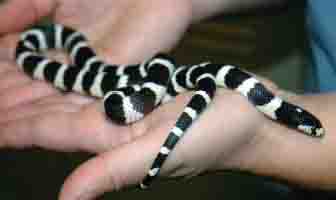
Pet Reptile California Kingsnake
Source: Rosamond Gifford Zoo Education Volunteers/Karen Marzynski
The Variable Kingsnake (also known as Thayer's Kingsnake) has easy to follow care instructions and have a docile personality. In captivity, a Variable Kingsnake can live 15 to 25 years and will grow to 2 to 3 feet in length. Young juveniles and hatchings require a 10 to 15 gallon glass terrarium with a top that is screened. Adult Variable Kingsnakes require a 20 to 30 gallon snake terrarium. Download a Variable Kingsnake care sheet here (PDF Download).
Rosy Boa
There are 4 types or species of Rosy Boas. These snakes can be tamed, are straight forward to maintain and are good for beginners. When bred in captivity they are docile. The diet consists of frozen pinkie mice and need to be fed 2x per week when young. Download a Petco care sheet for the Rosy Boa here. Subspecies include the Coastal Rosy Boa, Desert Rosy Boa, Central Baja Rosy Boa and the Mexican Rosy Boa. The lifespan is approximately 15 years and these reptile pets can grow to 20" to 42". The snake terrarium should be a 20 gallon long glass tank.East African Sand Boa
The East African Sand Boa (Kenyan Sand Boa) can grow to 30 inches (females are longer than males) with a lifespan of 15 years. Two or three snakes can be kept in a 20 gallon reptile terrarium. The best substrate for this breed is shredded newspaper or paper towels, simplifying care. Diet consists of frozen pinkie mice. To learn more download this PDF on Sand Boa Care.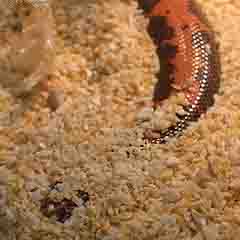
Sand Boas require a Terrarium with Deep fine Sand or Dry Mulch
Source: wikimedia, OpenCage
Ball Python
The Ball python is one of the most popular pet snakes. The snake is available in a variety of colors and can grow to between 3.5 and 6 feet in length. The snake will live in captivity for 25 - 25 years. Only buy snakes born in captivity since snakes caught in the wild can be difficult to feed in captivity. The pet reptile terrarium will need to b 40 to 50 gallons in size. As the name implies, they are known for the way they curl into a ball.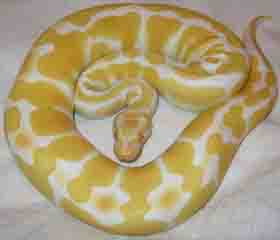
Ball Pythons are popular pets. They require a hide box, and a substrate such as cypress bark or aspen shavings.
Source: Wikimedia, WingedWolfPsion
Garter Snake
The Garter snake has 12 subspecies. The snake can live from 10 to 15 years in captivity and will grow to 18" to 36" in length. The terrarium should be 15 gallons, but since these snakes don't climb, the height can be as low as 12 to 14 inches. Snakes may bite until they are used to handling. Diet varies based on the sub-species, but generally consists of pinkie mice, worms, minnows, slugs and tadpoles. The snake digests quickly, resulting in the frequent need to clean feces from the cage. For more information on Garter Snakes download this care sheet from Petco (PDF).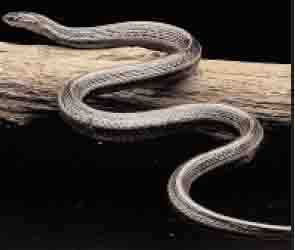
Garter Snakes can grow to 2 to 5 feet long
Brown House Snake (African House Snake)
The Brown House Snake (African House Snake) is an easy to keep snake that can grow from 2 ft to 6 ft. in length. The snakes can live from 12 to 15 years. They require a reptile terrarium that is 10 to 15 gallons. The selected reptile cage substrate should allow the snake to burrow, with good choices being newspaper, aspen shavings or pine shavings. For more information download this Brown House Snake Care sheet from Petco.
Have a Snake Related Question for our Vet? We Will Answer it for Free!
Do you need some snake care advice? Just ask a question and our Vet will answer it as soon as possible.
If your question is medical or behavior related, please include information such as species, age, diet, habitat and anything related to the medical history of your lizard.
Please upload a picture of your lizard, especially if you believe it will help the Veterinarian. Please know that we receive many questions and answer them on a first come, first served basis. If you need an immediate response, we suggest you use this online veterinary service that is available now to answer your questions.
References for Pet Snakes:
The 25 Best Reptile and Amphibian PetsR.D. Bartlett
Rosamond Gifford Zoo Education Volunteers
Willmet Pet Center, Wilmette, IL
Best West Pet Foods
Western New York Herpetological Society
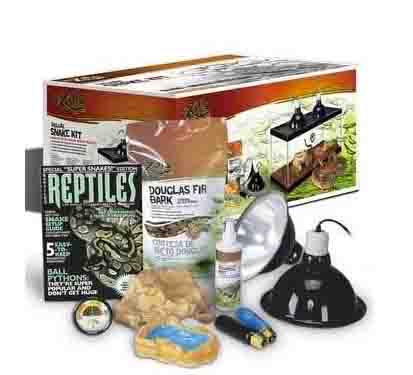
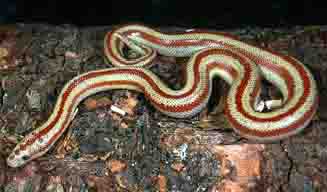
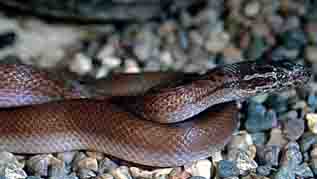
Comments
Have your say about what you just read! Leave me a comment in the box below.